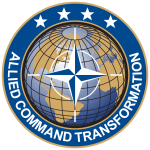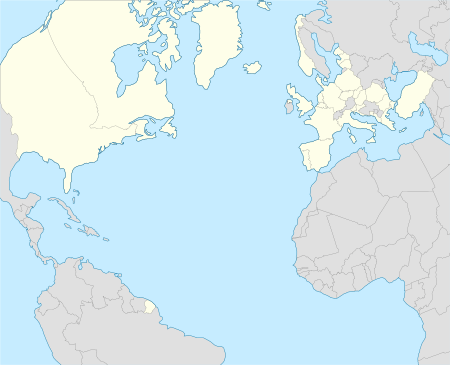Allied Command Operations
Allied Command Operations (ACO) is one of the two strategic commands of the North Atlantic Treaty Organization (NATO), the other being Allied Command Transformation (ACT). The headquarters and commander of ACO is Supreme Headquarters Allied Powers Europe (SHAPE) and Supreme Allied Commander Europe (SACEUR), respectively.
Structure
The NATO Military Command Structure consists of two strategic commands directed by the North Atlantic Council:[1]
- Liaison: Provides advice and support to the NAC
| Political strategic level: | |||||||||||||||||||
| NATO SG (NAC) Brussels, BE | IS Brussels, BE | ||||||||||||||||||
| Military strategic level: | |||||||||||||||||||
CMC (NATO MC) | |||||||||||||||||||
 SACEUR (ACO, SHAPE) Mons, BE |  SACT (ACT, HQ SACT) Norfolk, US | ||||||||||||||||||
| Operational level: | |||||||||||||||||||
Under ACO, there are three joint force operational headquarters and several single service commands:[2]
- Allied Joint Force Command Brunssum (JFCBS), Netherlands
- Allied Joint Force Command Naples (JFCNP), Italy
- Joint Force Command Norfolk (JFC-NF), United States
Single-service commands:
- Allied Air Command (AIRCOM) at Ramstein, Germany
- Allied Land Command (LANDCOM) at Izmir, Turkey
- Allied Maritime Command (MARCOM) at Northwood, United Kingdom
Other commands:
- Naval Striking and Support Forces NATO (aka. Strike Force NATO, STRIKFORNATO) at Oeiras, Portugal
- NATO Communication and Information Systems Command (NCISG) at Mons, Belgium
Joint Force Command Norfolk
Joint Force Command Norfolk (JFCNF) provides a critical capability to Supreme Allied Commander Europe’s (SACEUR) operational responsibilities. JFCNF was established out of the allied assessment of a changing security environment that emphasizes the trans-Atlantic as a critical domain. As an organization governed by an international memorandum of understanding (MoU), the command provides the capability to act early in a crisis to ensure a joint deterrent response and improve the responsiveness of NATO within that trans-Atlantic domain. JFCNF works seamlessly with allies and NATO partners in all domains and to provide awareness and synchronization with allies, while ensuring readiness and contributing to NATO objectives and core tasks. The NATO functions of JFCNF are related to the transition from a crisis to a high-intensity conflict. In this role, the command will contribute to enhance NATO’s warfighting capability.[3] Established in 2018, the first JFCNF commander is Vice Admiral Andrew L. Lewis, USN who also commands the recently re-established United States Second Fleet, also headquartered in Norfolk, Virginia.[4][5]
See also
- Allied Command Transformation
- Operational headquarters of the European Union
- Berlin Plus agreement
References
- "Command Structure" (PDF). NATO. Retrieved 19 October 2019. and "Military Command Structure". shape.nato.int. Supreme Head Allied Powers Europe. 12 February 2020. Retrieved 12 February 2020.
- "Structure". NATO. Retrieved 14 June 2014.
- "Joint Force Command Norfolk Conducts Trans-Atlantic Security Seminar". Joint Force Command Norfolk Public Affairs. 2019-01-15.
- Babb, Carla (2018-08-06). "US Navy's Top Admiral Cites Increased Threat in Ocean Nearest Washington". voanews.com. Retrieved 2018-08-12.
- LaGrone, Sam (2018-11-29). "U.S. 2nd Fleet Racing Toward a 2019 Operational Capability". USNI News. Retrieved 2018-12-01.
